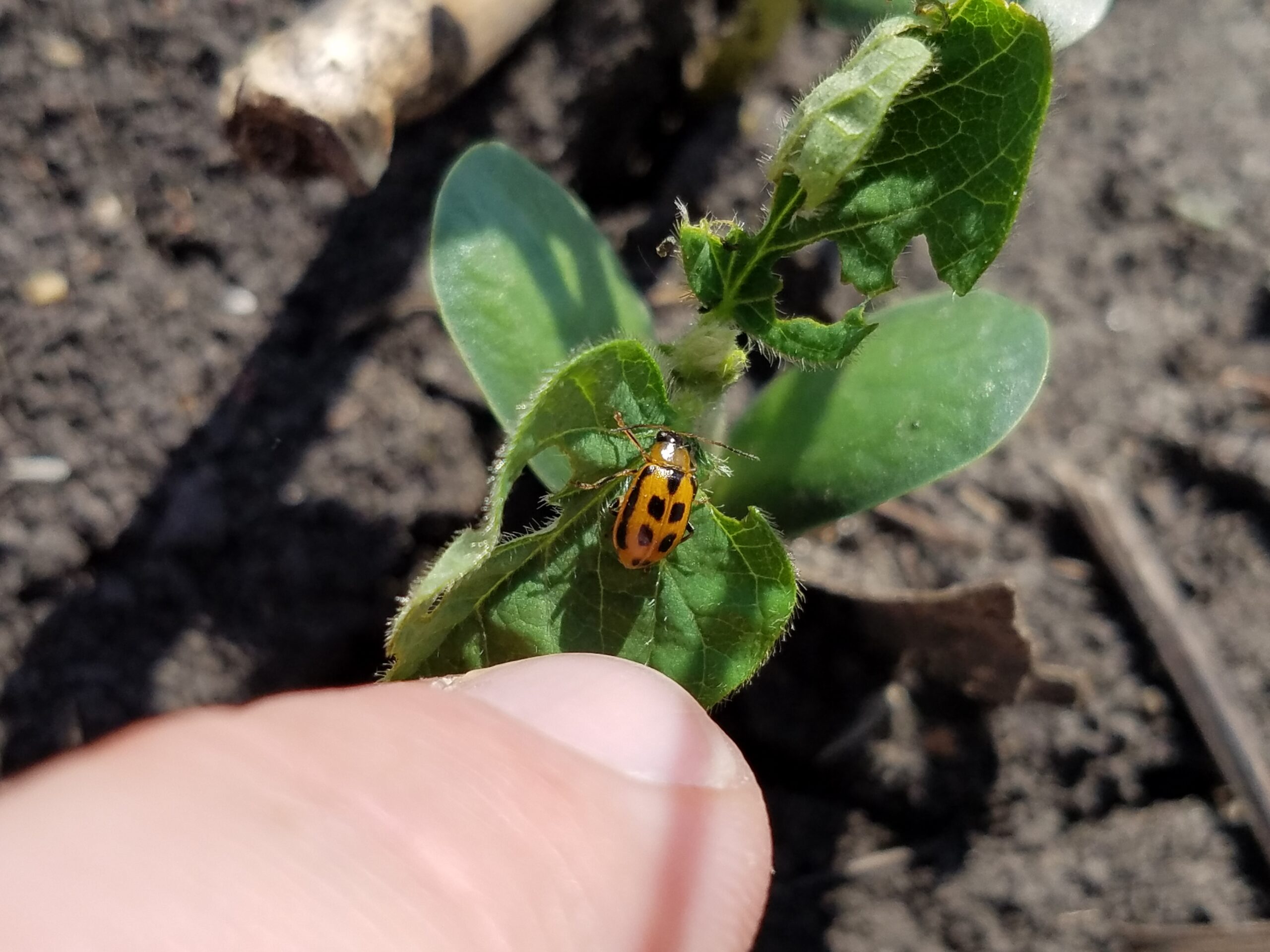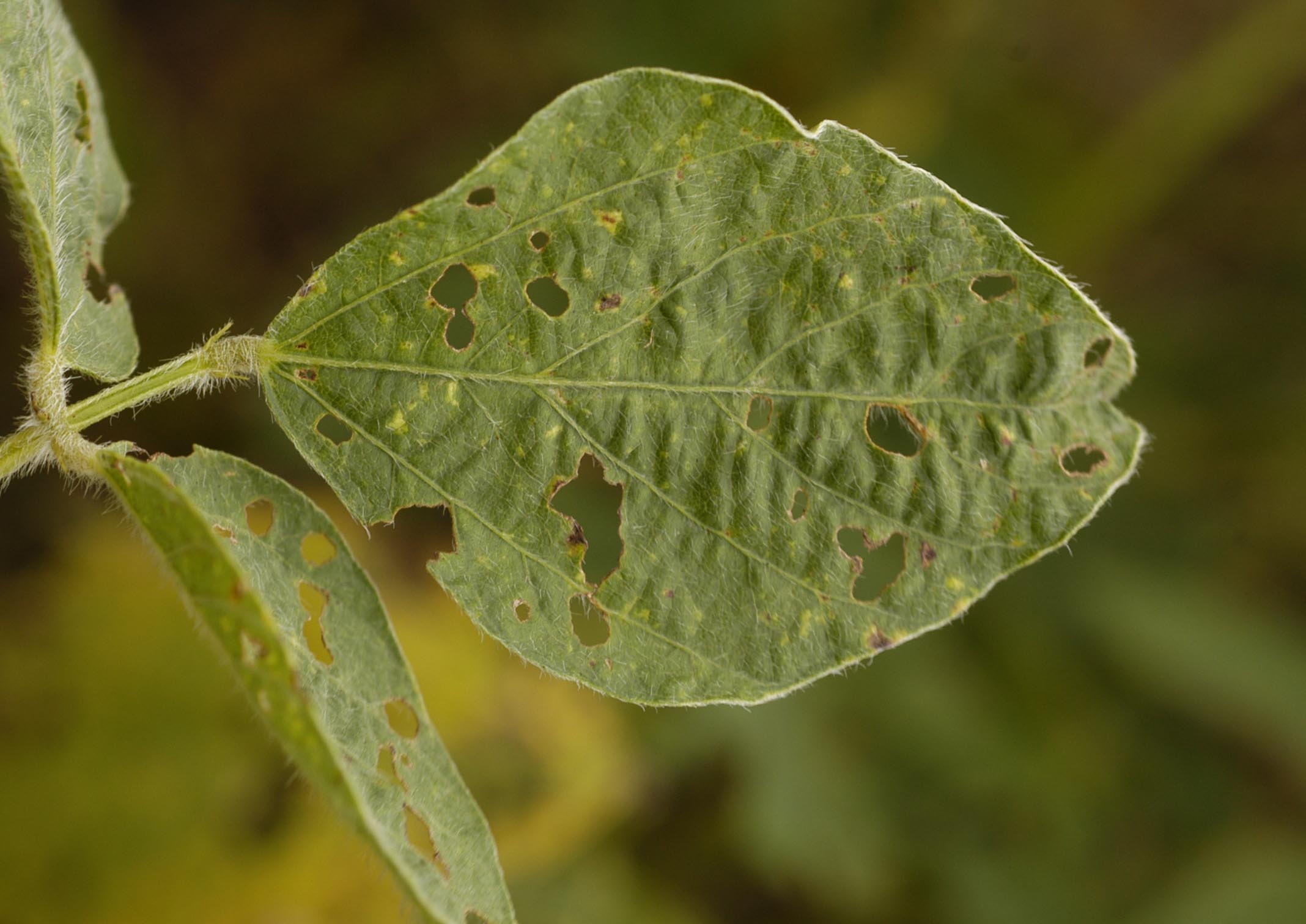Bean leaf beetles are among the first insect pests we see each spring. The adults leave their overwintering sites when temperatures begin to warm up and look for beans and other legumes to feed on. In many cases, the first bean fields to emerge act as a “magnet” for bean leaf beetles, resulting in damage and conspicuous populations of the insects. While the defoliation associated with this injury is rarely more than a cosmetic issue, this species has the potential to vector bean pod mottle virus early in the season and cause direct injury to pods during seed fill.

seedling. Note the black triangle behind the head.
(Photo: Nick Seiter, University of Illinois)
Bean leaf beetles go through two generations each year in Illinois. The overwintered adults lay eggs in the soil within bean fields in the spring. While their color (red or brown) and pattern (4 spots on their wings or no spots) vary, all bean leaf beetles will have a triangular marking just behind their head that points backward (Image 1).
The larvae resemble corn rootworm larvae since they are in the same family; they feed on soybean roots and nodules, but the impact of this is minimal. The first generation adults emerge in the middle of the summer (typically July) and lay their eggs. The second-generation adults then emerge later in the summer (August-September) and seek overwintering sites, including leaf litter in wood lots and soybean residue, when temperatures cool down in the fall.
While defoliation from bean leaf beetle feeding is common, it is rare for this defoliation to reach economically damaging levels in Illinois. The potential for bean leaf beetle to transmit viruses, especially bean pod mottle virus (Image 2), is more concerning. Bean pod mottle virus can reduce soybean yield, especially when plants are infected early in the season.

mottle virus. This leaf also shows evidence of insect defoliation,
which could have been caused by bean leaf beetle feeding.
(Photo: Nathan Kleczewski, University of Illinois)
Early control of bean leaf beetles can reduce bean pod mottle virus infection, though the disease can also be spread through seed and by other leaf-feeding beetles. During the seed fill stages, bean leaf beetle adults will feed on and scar soybean pods, causing direct damage to the seeds. This feeding can reduce yield and quality, and allows an entry point for pathogens.
Soybeans are fairly tolerant of defoliation. Therefore, the economic thresholds for control of defoliating insects in soybean are quite high; consider a rescue treatment if defoliation exceeds 30% prior to bloom or 20% after bloom and the target pest is still present in the field.
Control of bean leaf beetles is more likely to provide an economic return in fields that both (1) have a high population of bean leaf beetles in the field during the early vegetative stages and (2) have a history of bean pod mottle virus. A control for the adults may be warranted towards the end of the season if pod scarring exceeds 5%.
If a damaging population occurs, bean leaf beetles can be effectively controlled with insecticides. Insecticide seed treatments will provide effective protection of seedling plants, but will not persist beyond the early vegetative stages. A broadcast application of a pyrethroid will generally provide effective control, although resistance to these materials is a concern in the southern U.S.
You are most likely to see infestations in the earliest planted fields during the seedling stages before surrounding fields have emerged and again in the latest planted fields at the end of the season after surrounding fields have begun to mature. Prioritize these fields when scouting for bean leaf beetles. While this pest is a near constant in Illinois soybean fields, management is not a challenge if you are willing to tolerate some “holey” foliage.


 and then
and then